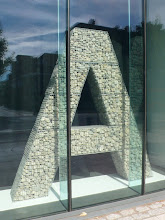187 Stoke Newington High Street
Vegetable spring rolls, spinach and fresh
to-fu curry and a Chang beer
One enters Yumyum through a very grand courtyard. The wrought iron gates must be over ten feet high and the courtyard houses a mosaic fountain, several Buddha statues and some small model temple buildings, as well as three domed, wooden eating areas. A flight of steps leads up to the imposing Georgian building with its large windows and flat front.


It is by far and away the most dramatic entrance I have encountered on my journey so far and must have been an important building* in Stoke Newington in its heyday. On entering one is greeted by a maître d’—all very formal. There is a large bar area and probably well over two hundred covers. This is some operation. The interior décor is all dark wood, mood lighting and subtly coloured translucent drapes separating the different eating areas and the bar. Tasteful objets d’art are placed throughout. The music is jazz-tinged instrumental covers, you have to actively listen to hear it.

We order some spring rolls. They come almost immediately, complete with a piece of carrot sculpted into the shape of a flower.

The waiters are dressed from head to toe in black and seem to glide across the floor. The service is professional and attentive, but stops short of being obsequious. It is a slick, well-oiled business operation, very different to many of the places I have visited along this stretch of road. There is clearly an emphasis on style, ambience, and a real ‘restaurant’ experience here. I suspect Yumyum is making the most of its position at the top of Church Street and catering to the well-heeled Stoke Newington set. Our main courses arrive, my curry is a little soupy, but very tasty.

I’m not convinced spinach and tofu is a traditional Thai curry dish, but maybe one that has been invented to satisfy the vegetarians seeking something different from the usual vegetable green curry. Before leaving I go downstairs to the toilets, where the opulence continues. Red panelled lighting in the ceilings, dramatic patterned wallpapers, polished marble tiles and a spectacular long red sink. There really is no expense spared here. I feel like I have accidentally strayed from my Kingsland Road to Stamford Hill path.

*187 Stoke Newington High Street
The London Road led to early settlement in Stoke Newington and much was concentrated at the junction with Church Street in the 17th century. A fine group of town houses was built north of the junction with Church Street in the early 18th century, and number 187, dated 1712, may have been built by the merchant Edward Lascelles, whose daughters sold it in 1755 to John Wilmer. Wilmer, a wealthy Quaker, was buried in a brick vault in the garden with a bell attached to his wrist, for fear of being buried alive. In 1794 the building was occupied by a schoolmaster and from 1832 until the Second World War by the invalid asylum for ‘respectable females’. The asylum was founded by Mary Lister in 1825 and intended to provide rest and medical care for domestic servants. In 1909 alterations converted the asylum into a hospital, which by 1917 was called Stoke Newington home hospital for women. The hospital had 31 beds in 1930. It moved to Stevenage during the Second World War and did not reopen after the war.
From its beginning the Invalid Asylum had a physician and surgeon in attendance every working day, and the attendance of a dentist is noted from 1866. In 1826, its first full year, the Asylum treated forty-seven women. By the time of its centenary in 1926, this number had risen to 264. The original purpose had also been extended, with convalescent and maternity cases being admitted. The Invalid Asylum was overseen by a Ladies Committee, and the establishment very quickly gained royal patronage, with Princess Augusta acting as Patroness from 1826 until 1840, when Queen Victoria accepted the role. Queen Victoria served as Patroness of the Invalid Asylum for over 60 years, and the tradition of royal patronage continued right up to the incorporation of the Home into the National Health Service in 1948.

No comments:
Post a Comment